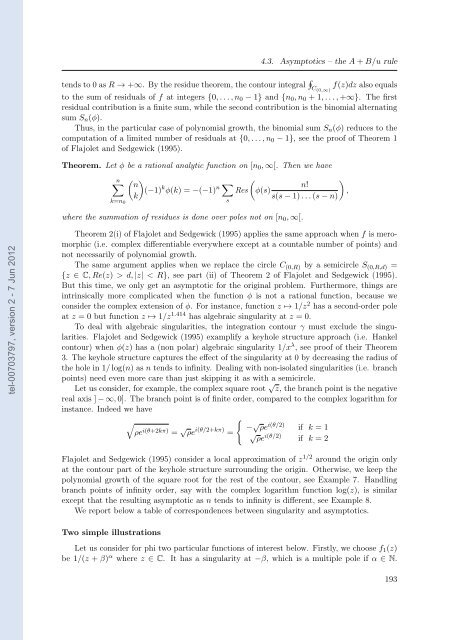Etude des marchés d'assurance non-vie à l'aide d'équilibres de ...
Etude des marchés d'assurance non-vie à l'aide d'équilibres de ...
Etude des marchés d'assurance non-vie à l'aide d'équilibres de ...
Create successful ePaper yourself
Turn your PDF publications into a flip-book with our unique Google optimized e-Paper software.
tel-00703797, version 2 - 7 Jun 2012<br />
4.3. Asymptotics – the A + B/u rule<br />
tends to 0 as R → +∞. By the residue theorem, the contour integral <br />
C f(z)dz also equals<br />
(0,∞)<br />
to the sum of residuals of f at integers {0, . . . , n0 − 1} and {n0, n0 + 1, . . . , +∞}. The first<br />
residual contribution is a finite sum, while the second contribution is the binomial alternating<br />
sum Sn(φ).<br />
Thus, in the particular case of polynomial growth, the binomial sum Sn(φ) reduces to the<br />
computation of a limited number of residuals at {0, . . . , n0 − 1}, see the proof of Theorem 1<br />
of Flajolet and Sedgewick (1995).<br />
Theorem. Let φ be a rational analytic function on [n0, ∞[. Then we have<br />
n<br />
k=n0<br />
<br />
n<br />
(−1)<br />
k<br />
k φ(k) = −(−1)<br />
n <br />
s<br />
<br />
<br />
n!<br />
Res φ(s)<br />
,<br />
s(s − 1) . . . (s − n)<br />
where the summation of residues is done over poles not on [n0, ∞[.<br />
Theorem 2(i) of Flajolet and Sedgewick (1995) applies the same approach when f is meromorphic<br />
(i.e. complex differentiable everywhere except at a countable number of points) and<br />
not necessarily of polynomial growth.<br />
The same argument applies when we replace the circle C (0,R) by a semicircle S (0,R,d) =<br />
{z ∈ C, Re(z) > d, |z| < R}, see part (ii) of Theorem 2 of Flajolet and Sedgewick (1995).<br />
But this time, we only get an asymptotic for the original problem. Furthermore, things are<br />
intrinsically more complicated when the function φ is not a rational function, because we<br />
consi<strong>de</strong>r the complex extension of φ. For instance, function z ↦→ 1/z2 has a second-or<strong>de</strong>r pole<br />
at z = 0 but function z ↦→ 1/z1.414 has algebraic singularity at z = 0.<br />
To <strong>de</strong>al with algebraic singularities, the integration contour γ must exclu<strong>de</strong> the singularities.<br />
Flajolet and Sedgewick (1995) examplify a keyhole structure approach (i.e. Hankel<br />
contour) when φ(z) has a (<strong>non</strong> polar) algebraic singularity 1/xλ , see proof of their Theorem<br />
3. The keyhole structure captures the effect of the singularity at 0 by <strong>de</strong>creasing the radius of<br />
the hole in 1/ log(n) as n tends to infinity. Dealing with <strong>non</strong>-isolated singularities (i.e. branch<br />
points) need even more care than just skipping it as with a semicircle.<br />
Let us consi<strong>de</strong>r, for example, the complex square root √ z, the branch point is the negative<br />
real axis ] − ∞, 0]. The branch point is of finite or<strong>de</strong>r, compared to the complex logarithm for<br />
instance. In<strong>de</strong>ed we have<br />
<br />
ρe i(θ+2kπ) = √ ρe i(θ/2+kπ) =<br />
<br />
− √ ρe i(θ/2) if k = 1<br />
√ ρe i(θ/2) if k = 2<br />
Flajolet and Sedgewick (1995) consi<strong>de</strong>r a local approximation of z 1/2 around the origin only<br />
at the contour part of the keyhole structure surrounding the origin. Otherwise, we keep the<br />
polynomial growth of the square root for the rest of the contour, see Example 7. Handling<br />
branch points of infinity or<strong>de</strong>r, say with the complex logarithm function log(z), is similar<br />
except that the resulting asymptotic as n tends to infinity is different, see Example 8.<br />
We report below a table of correspon<strong>de</strong>nces between singularity and asymptotics.<br />
Two simple illustrations<br />
Let us consi<strong>de</strong>r for phi two particular functions of interest below. Firstly, we choose f1(z)<br />
be 1/(z + β) α where z ∈ C. It has a singularity at −β, which is a multiple pole if α ∈ N.<br />
193
















